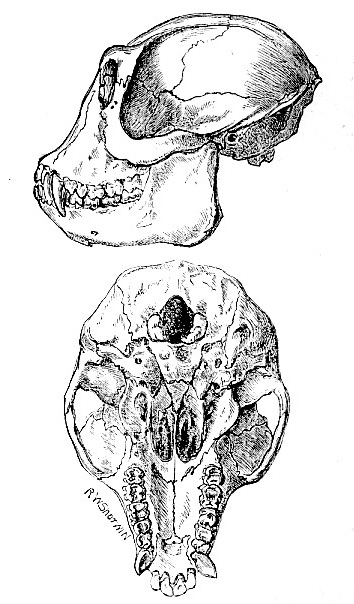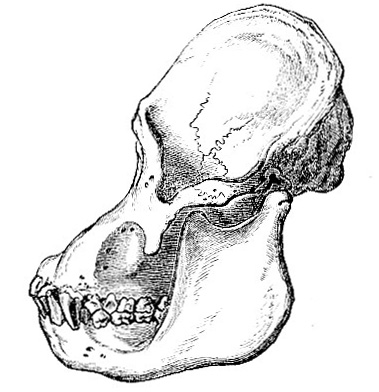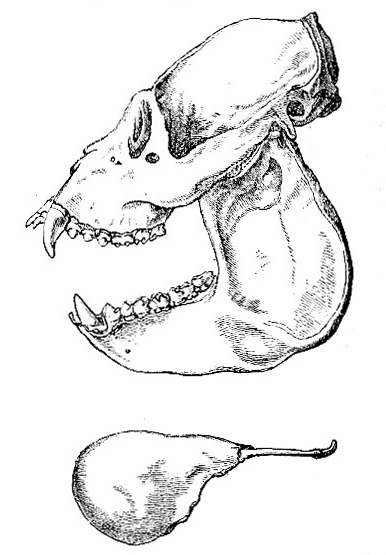1902 Encyclopedia > Ape > Ape Skeleton - Introduction. The Axial Skeleton - The Skull.
Ape
(Part 16)
<
(C) The Anatomy of Apes (cont.)
Ape Skeleton - Introduction
The skeleton of apes generally, if we except the tail, consists of but few more bones than that of man. The proportions of its parts, except as regards the relative length of the limb bones, are also much as in man; nor are their shapes, except those of the jaws and haunch bones, greatly different. The same general resemblance may be predicated of their minute structure, though the osseous tissue is generally rather dense, and the medullary cavity in the long bones small.
The Axial Skeleton. -- The Skull
The axial skeleton consists of the skull and the vertebral column, and the general shape of its more anterior portion, the skull, has already been indicated when speaking of the head as part of the external form. It is scarcely ever so evenly balanced on the occipital condyles as in man.

Fig. 14 -- Side view and base of the skull of the Douc (Semnopithecus nemaeus). From De Blainville.
The artificial division of the skull into a cranial and a facial portion may be here conveniently adopted from human anatomy. The proportion of the latter portion to the former varies greatly from age and sex, owing mainly to the differences produced through the development of large and powerful canine teeth in the adult males of most species. This proportion also varies in an irregular manner as we descend (through the series of apes) from those which are most like man. Thus the facial part is already very large in the orang and chimpanzee, much more so than in Semnopithecus, where most of the ape cranial characters are moderately developed, or even than in many Cercopitheci; but it attains its maximum of relative size in the Cynocephali, above all in C. porcarius. In the Cebidae the facial part is relatively smaller than in the Simiadoe, with the exception of Mycetes, while in Chrysothrix the facial portion of the skull is relatively smaller than even in man himself. The relation of the face to the cranium (or brain case) is best shown by the craniofacial angle, which is estimated by means of two lines, one drawn parallel to the base of the skull (from the front margin of the occipital foramen to the anterior end of the cerebral surface of the presphenoid), the other drawn from the front end of that base to the middle of the lower margin of the upper jaw.
No ape, especially no ape of the Old World, presents to elevated and rounded a contour in the frontal region as does man. It is in American forms, especially in the genus Pithecia, that we find the greatest resemblance to man in this respect; but the skiull is lofty in the orang.
The convexity of the occiput is well marked in Simia, Troglodytes niger, and Hylobates, while in the inferior Simiadae it is flat. Its maximum of production, however, is met with in the genus Chrysothrix.
Ridges for muscular attachment, or other bony prominences, more or less disguising the rotundity of the cranium, are very generally developed, except in the smallest species. Such ridges are met with at once at their very maximum of extent in Troglodytes gorilla. In that animal an enormous sagittal ridge traverses the middle of the sinciput antero-posteriorly, joining at its hinder end a prodigious lambdoidal crest for the insertion of the muscles of the neck. A very largely developed supra-orbital ridge runs transversely above the orbits, which it obliquely overhangs. The orang has no supra-orbital ridge, but in the other large Simiadae all these ridges are more or less developed, and moderate sagittal and lambdoidal ridges are found in Mycetes, Cebus, Pithecia, and some other of the Cebidae.
The mastoid process never attains in apes the large relative size it has in man; but it is prominent in the baboons and larger Macaci, as well as Troglodytes, its development bearing relation to the size and weight of the head. As the mastoid diminished we find that the under surface of the petrous bone assumes a swollen or "bullate" condition.

Fig. 15 -- Side view of the skull of adult Orang (Simia satyrus). From Trans. Zool. Soc. vol. i, pl. 53.
The orbits are in T. gorilla much as in man, but in the orang they are more rounded. They become very large in Hylobates, but attain an enormous size in Nyctipithecus. The extent to which each orbit opens into the adjacent temporal fossa, i.e., the size and shape of the sphenomaxillary fissure, varies considerably. It is narrow and much elongated in the gorilla and in Cynocephalus; it is short in the Semnopithecinae and in Ateles, but opens widely so as to expose the vidian foramen. It is most completely closed of all in Mycetes, where it sometimes all but disappears entirely. The olfactory chamber is narrow and deep in the lower Simiadae. The cribriform plate of the ethmoid is generally separated from the presphenoid by the junction of the orbital plates of the frontal. Such, however, is not the case in the orang and chimpanzee, though it is so in the gorilla and in Hylobates.
The plane of the foramen magnum, as compared with the basi-cranial axis, varies with the projection of the occiput. It generally forms a less open angle with that axis than in man, but in Chrysothrix the angle is yet more open than in the human skull.
The zygomata are arched both outward and upwards in the gorilla and some baboons, but decrease in relative as well as absolute size the smaller forms, -- notably in Chrysothrix. No long slender styloid process is normally attached to the skull, though such may be able case in Cynocephalus. The vaginal process never attains the size it does in man, though it is considerable in the gorilla, and sometimes noticeable in Simia. A bony meatus auditorius externus exists in all the Simiadae, and is absent in the whole of the Cebidae. In Nyctipithecus the ali-sphenoid is almost shut out from the parietal by the close approximation of the squamosal to the malar. In Cebus there is often a large malar foramen.
The premaxillary bones have throughout the apes a distinctness of development and a relative size not found in man, the sutures separating them from the maxillaries remaining visible, with the exception of the chimpanzee, after the adult dentition has been attained. The maxillaries themselves develop great swollen tuberosities in the Cynocephali, and a similar structure is developed even in Macacus niger.

Fig. 16 -- Side views of the skull and hyoid bone of Howling Monkey (Mycetes seniculus). From De Blainville.
The nasal bones are small, generally flatter than in man. In the orang they are quite flat. They are convex in some of the Semnopitheci and in the Cynocephali, but the proboscis monkey has its nasal bones no more developed than have other species of its genus. The nasals seem to attain their maximum of relative size in Mycetes.
The lower jaw, or mandible, is always in one piece in adults. It is most man-like in the siamang, since we there alone find a slight chin. On the other hand, in Hylobates the angle is produced downwards and backwards, and we find the same in Hapale. Its maximum of relative size is attained in Mycetes, where the very broad ascending ramus serves to protect and shelter the enormously developed body of the hyoid.
Air cells may be developed, as in the gorilla, in the parts adjacent to the mastoid. Frontal sinuses are generally absent in the Simiadae, being replaced by a coarse diploë. We find them, however, in the Cebidae, and in Cebus they are often larger than they are in man. The total length of the cerebral cavity is never so much as 2 1/4 times the length of the basi-cranial axis.
The sutures of the skull become entirely obliterated with age. In the gorilla the sutures assume as more dentated structure than is found in any other ape or in man. The internasal suture becomes early obliterated in most of the Simiadae. The tentorium is sometimes ossified, as in the Cebinae and Mycetes. From Hylobates downwards there is a small cerebellar fossa on the inner surface of the petrosal.
Read the rest of this article:
Ape - Table of Contents
|


